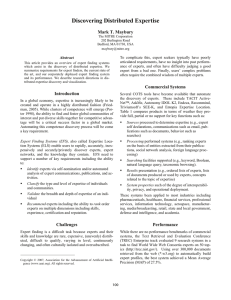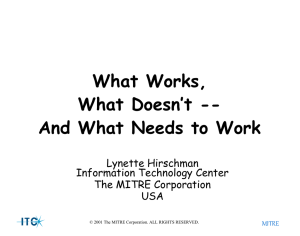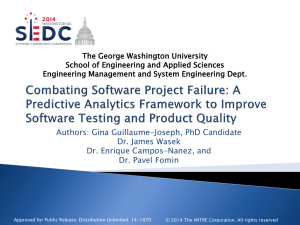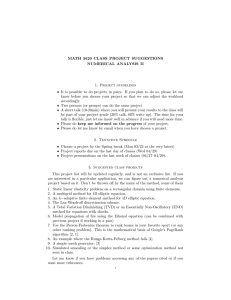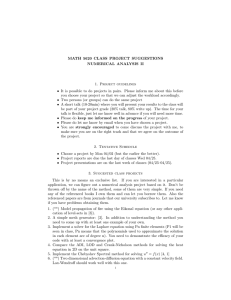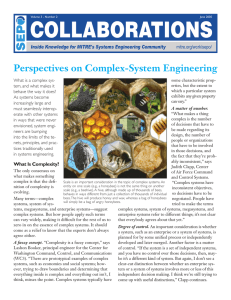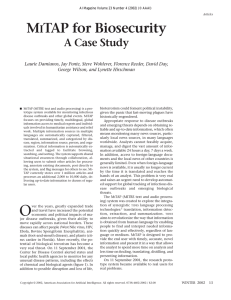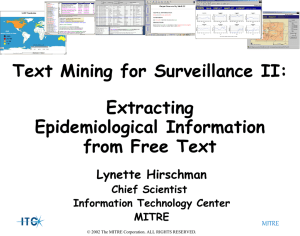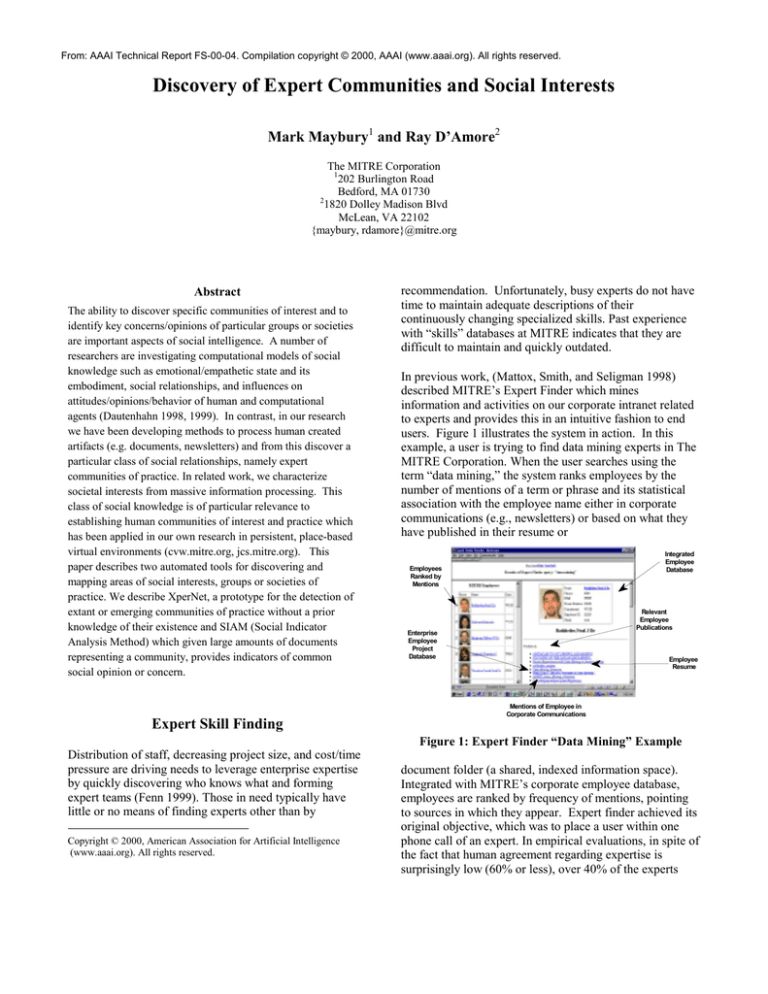
From: AAAI Technical Report FS-00-04. Compilation copyright © 2000, AAAI (www.aaai.org). All rights reserved.
Discovery of Expert Communities and Social Interests
Mark Maybury1 and Ray D’Amore2
The MITRE Corporation
1
202 Burlington Road
Bedford, MA 01730
2
1820 Dolley Madison Blvd
McLean, VA 22102
{maybury, rdamore}@mitre.org
Abstract
The ability to discover specific communities of interest and to
identify key concerns/opinions of particular groups or societies
are important aspects of social intelligence. A number of
researchers are investigating computational models of social
knowledge such as emotional/empathetic state and its
embodiment, social relationships, and influences on
attitudes/opinions/behavior of human and computational
agents (Dautenhahn 1998, 1999). In contrast, in our research
we have been developing methods to process human created
artifacts (e.g. documents, newsletters) and from this discover a
particular class of social relationships, namely expert
communities of practice. In related work, we characterize
societal interests from massive information processing. This
class of social knowledge is of particular relevance to
establishing human communities of interest and practice which
has been applied in our own research in persistent, place-based
virtual environments (cvw.mitre.org, jcs.mitre.org). This
paper describes two automated tools for discovering and
mapping areas of social interests, groups or societies of
practice. We describe XperNet, a prototype for the detection of
extant or emerging communities of practice without a prior
knowledge of their existence and SIAM (Social Indicator
Analysis Method) which given large amounts of documents
representing a community, provides indicators of common
social opinion or concern.
recommendation. Unfortunately, busy experts do not have
time to maintain adequate descriptions of their
continuously changing specialized skills. Past experience
with “skills” databases at MITRE indicates that they are
difficult to maintain and quickly outdated.
In previous work, (Mattox, Smith, and Seligman 1998)
described MITRE’s Expert Finder which mines
information and activities on our corporate intranet related
to experts and provides this in an intuitive fashion to end
users. Figure 1 illustrates the system in action. In this
example, a user is trying to find data mining experts in The
MITRE Corporation. When the user searches using the
term “data mining,” the system ranks employees by the
number of mentions of a term or phrase and its statistical
association with the employee name either in corporate
communications (e.g., newsletters) or based on what they
have published in their resume or
Integrated
Employee
Database
Employees
Ranked by
Mentions
Relevant
Employee
Publications
Enterprise
Employee
Project
Database
Employee
Resume
Mentions of Employee in
Corporate Communications
Expert Skill Finding
Figure 1: Expert Finder “Data Mining” Example
Distribution of staff, decreasing project size, and cost/time
pressure are driving needs to leverage enterprise expertise
by quickly discovering who knows what and forming
expert teams (Fenn 1999). Those in need typically have
little or no means of finding experts other than by
Copyright © 2000, American Association for Artificial Intelligence
(www.aaai.org). All rights reserved.
document folder (a shared, indexed information space).
Integrated with MITRE’s corporate employee database,
employees are ranked by frequency of mentions, pointing
to sources in which they appear. Expert finder achieved its
original objective, which was to place a user within one
phone call of an expert. In empirical evaluations, in spite of
the fact that human agreement regarding expertise is
surprisingly low (60% or less), over 40% of the experts
returned by Expert Finder are judged by humans as experts
(a measure of “precision”). Expert Finder also finds about
30% of all the experts identified by human experts (a
measure of “recall”) (Mattox, Maybury, and Morey 1999).
Locating Expert Networks
In current research we are investigating the discovery of
communities of practicing experts via a prototype called
XperNet. MITRE Technology Centers conduct applied
research in a number of technology areas related to the
sponsor's mission. As such they often partner directly with
project departments and form teams with diverse but
complementary skills and problem knowledge.
Organizationally, staff working related technologies and
problems can be modeled as social networks that form the
basis for abstracting expertise. According to (Ackerman et
al. 1999), expertise networks can be defined as
specializations of an organization's social network.
They consider not only how people are socially
arranged but what expertise they have and trade.
XperNet is designed to extract expertise networks.
XperNet uses statistical clustering techniques and social
network analysis to glean networks or affinity groups
consisting of people having related skills and interests.
Networks are extracted from various work contexts or
activities such as projects, publications, and technical
exchanges. In the first generation XperNet architecture,
Figure 2, expertise signatures are extracted from a variety
of sources including published documents, public share
folders, and project information. Higher levels of expertise
are associated with features such as document authorship,
explicit reference or citation, network centrality, personal
web pages, and project membership. Lower expertise
levels reflect fewer expertise indicators and possibly
counter-indications such as being a member of the
administrative staff.
Expertise signatures are input to a simulated annealing
clustering algorithm that uses a dynamic merging scheme to
collapse lower-level clusters into larger groupings-- the
core cluster. The network expansion algorithm “grows” the
network by using project and other organizational
information to augment expertise ratings and identify
additional cluster members. In some cases, members that
have complementary skills or serve in supporting roles are
incorporated into the cluster. Expertise indicators can be
used to indicate expertise ratings for each network member.
The current XperNet algorithm is under evaluation at
MITRE's Information Technology Center
(www.mitre.org/resources/centers/it). Initially, expertise
networks, generated from user surveys, were compared to
automatically generated expertise networks. We found that
four nominated core expertise areas (collaboration,
knowledge management, advanced instructional training,
and language processing) had a strong correlation to
existing Center departments, however, in addition many
experts from organizations outside of the Center were
included, making explicit the informal organization. In
empirical precision/recall evaluations comparing human to
XperNet performance (Maybury, D’Amore, and House
2000a), approximately 70% of the top ten automatically
identified experts were in the manually identified list
(precision). In addition, over 40% of the experts included
in manually described expert communities were included
by XperNet in its list of experts (recall).
Planned research is focused on developing a framework for
modeling communities to include aspects of membership,
role, and influence.
Related to this, a sort of "social
semantics" (e.g., expertise, activism) is essential to
characterizing community behavior within a specific
domain. To motivate this, we have examined problems like
Y2K remediation and are currently looking at a specific
instance of public opinion on the use of pesticides for crop
eradication. General research is focused on the underlying
content analysis and social network analysis methods.
Social Indicator Analysis Method
Figure 2. XperNet Computational Architecture
Having discovered a community, it is often useful to
understand and track their interests, concerns, and
viewpoints over time. The ability to determine social
interests is an important facility for political analysis,
market analysis and investment. Unfortunately, social
interests and structure are often implicit. The Social
Indicator Analysis & Monitoring (SIAM) system computes
social indicators based on the social context of selected
communication patterns. Communities are modeled as
social networks in which a node may represent an
individual, group, organization, or some other entity (e.g., a
country). Network nodes can be abstracted as an array of
communication elements and message collections
organized with regard to content, chronology, or other
discriminating features (e.g., business function). The
topicality of the messages, frequency of occurrence, and
logical location within a collection can be used to compute
the “importance” of social contexts associated with each
community member.
down to interpret why a particular country or sector has a
specific rating. This enables the user to quickly assess
where risks are as well as track down the specific causes.
SIAM has been used to assess the significance of key
societal issues across geographic regions and over selected
time intervals using sampling-based collection schemes.
The underlying content analysis technology in SIAM was
used to predict the likelihood of a topic being of social
interest to a country (and by inference an indication of a
country's concern and/or investment in that area). In an
earlier effort, SIAM was used to perform a broad area
threat assessment of Y2K compliance in Central and South
America. Figure 3 illustrates the results of processing
30,000 web sites with information regarding Y2 readiness
within the finance, energy, transportation, and
telecommunication business sectors. Using English,
Spanish, and Portuguese profiles against similar language
web sites, SIAM was able to assess the Y2K readiness as
measured by what individual societies were reporting in
academic, industrial or government sources.
This paper overviews our research in discovery of expert
groups and the induction of issues of concern using social
analysis of information. The reported tools -- Expert
Finder, XperNet and SIAM -- provide promise to enabling
discovery of expert groups and social networks. This work
has possibilities for many application areas and also raises
many interesting research questions regarding how much
social network information and societal concerns can be
inferred from on-line documents and the web. It equally
raises privacy concerns regarding the automated
inferencing of individual properties from shared artifacts.
MEXICO
CNTRY
Finance Energy
Trans.
Telecomm Z-Ave
argentina
1.476278 2.434932
0.8366
1.9553 1.67579
bermuda
0.888375 -0.06594
1.9661
0.1754 0.740966
bolivia
-0.65204 -0.55287
-0.6155
-0.6380 -0.61458
brazil
1.869995 0.27763
0.7220
1.5664 1.109025
chile
1.242407 0.065475
1.9946
0.8680 1.042629
colombia
-0.5338 -0.38638
-0.4981
-0.5096 -0.48196
costa_rica
-0.39694 -0.29373
-0.4429
-0.2979 -0.35789
ecuador
-0.6348 -0.54902
-0.6117
-0.6289 -0.60608
el_salvador
-0.6304 -0.52669
-0.5945
-0.6204 -0.59299
guatemala
-0.65019 -0.54851
-0.6130
-0.6366 -0.61208
guyana
-0.65496 -0.55555
-0.6146
-0.6410 -0.61652
honduras
-0.65361 -0.55464
-0.6161
-0.6409 -0.61632
mexico
1.656809 2.306324
1.1496
2.0101 1.780716
nicaragua
-0.60775 -0.52549
-0.5961
-0.6028 -0.58303
panama
-0.64749 -0.54845
-0.6090
-0.6352 -0.61004
paraguay
-0.64199 -0.54268
-0.6052
-0.6190 -0.60222
peru
-0.42739 -0.31945
-0.4733
-0.3972 -0.40431
puerto_rico -0.65496 -0.55555
-0.6162
-0.6401
-0.6167
uruguay
0.987168 1.667379
1.2754
1.2915 1.305344
venezuela
-0.33471
-0.2268
-0.4382
-0.3592 -0.33974
BELIZE
GUATEMALA HONDURAS
EL SALVADOR
NICARAGUA
COSTA
RICA
VENEZUELA
COLOMBIA
ECUADOR
BRAZIL
PERU
BOLIVIA
PARAGUAY
PANAMA
CHILE
URUGUAY
ARGENTINA
Summary
Acknowledgements
We are indebted to Chris Elsaesser for the original idea for
an expert finder and David Mattox, Inderjeet Mani, and
David House for their assistance with the creation of
MITRE’s Expert Finder. We thank Manu Konchady for his
work with Raymond D'Amore on the core research and
development of XperNet and SIAM.
References
Fina nce
Ene rg y
Tra ns .
Te le co m m
Z-Ave
Figure 3. SIAM Example for Central and South
American Y2K
The spreadsheet output shown in Figure 3 is a reflection of
hundreds of queries run against web sites in individual
countries measuring the volume of reporting on Y2K
within particular sectors. As is indicated by the color codes
(red = high risk; yellow = moderate risk; green = low risk),
certain countries have above or below average
communications on Y2K topics. This can be compared to
the degree of reliance each sector in each country has on
the infrastructure which in turn can be used as an indicator
of the likelihood of risk in that sector. We can then present
this information as a bar graph or as a geo-spatial display
for easy interpretation.
This low cost, automated,
multilingual analysis of over 30,000 web sites resulted in
"bottom-up" societal predictions that eliminated selfreporting biases evident in a human-intensive Gartner
Group survey analysis. It also provided predictions
consistent with official State Department assessments that
require hundreds of humans to complete.
Source
documents that served as the basis for these assessments
are incorporated in the system so that an analyst can drill
Ackerman, M., McDonald, D., Lutters, W., and
Muramatsu, J. 1999. Recommenders for Expertise
Management. In Proceedings of the ACM SIGIR '99
Workshop on Recommender Systems: Algorithms and
Evaluation University of California, Berkeley, August 19,
1999.
Dautenhahn, K. (ed.) 1998, 1999. "Socially Intelligent
Agents", Applied Artificial Intelligence, Vol. 12 (7-8),
1998, and Vol. 13 (3) 1999.
Dautenhahn, K. (ed.) 2000a. Human Cognition and Social
Agent Technology. John Benjamins, Forthcoming.
Fenn, J. 1999. Skill Mining: An Emerging KM
Technology. Gartner Group Report.
Mattox, D., Maybury, M. and Morey, D. 1999. Enterprise
Expert and Knowledge Discovery. In Proceedings of the
International
Conference
on
Human
Computer
International (HCI 99). 23-27 August 1999. Munich,
Germany.
Maybury, M., D’Amore, R. and House, D. 2000a.
Automated Discovery and Mapping of Expertise. In
Ackerman, M., Cohen, A., Pipek, V. and Wulf, V. (eds.).
Beyond Knowledge Management: Sharing Expertise,
Cambridge: MIT Press. Forthcoming.

